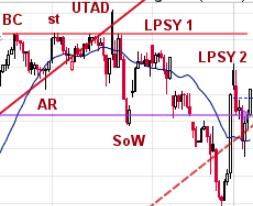Wyckoff at Work in the Intraday Timeframe
The intraday timeframe in trading refers to the period within a single trading day when a trader makes buy or sell decisions on short-term price movements. In this fast-paced environment, understanding the dynamics of market movements is crucial for successful trading. One trading approach that has stood the test of time is the Wyckoff method.
Richard D. Wyckoff, a pioneer in technical analysis, developed the Wyckoff method in the early 20th century. His approach focuses on studying the relationship between supply and demand to gauge the market sentiment and identify potential trade opportunities. The Wyckoff method is based on the premise that the market moves in a series of waves that can be predicted and profited from.
In the intraday timeframe, traders can apply the principles of the Wyckoff method to analyze price movements and make informed trading decisions. One key concept in Wyckoff analysis is the accumulation and distribution phases. During accumulation, smart money accumulates shares at lower prices before a potential uptrend. Conversely, during distribution, smart money sells off shares to the public before a potential downtrend.
By identifying these phases in the intraday timeframe, traders can anticipate potential price movements and adjust their trading strategy accordingly. For instance, if a stock is in the accumulation phase and shows signs of accumulation, traders may consider buying the stock at a discounted price with the expectation of a price increase.
Another important aspect of the Wyckoff method is the use of volume analysis to confirm price movements. In the intraday timeframe, analyzing volume can provide valuable insights into market sentiment and the strength of a price movement. High volume during a price increase suggests strong buying interest, while low volume during a price decrease indicates weak selling pressure.
Traders can also use price spread analysis to identify potential entry and exit points in the intraday timeframe. Price spread refers to the difference between the high and low price of a security during a trading session. By analyzing price spread patterns, traders can determine the strength of a price movement and make more informed trading decisions.
Incorporating the Wyckoff method in the intraday timeframe requires patience, discipline, and continuous learning. Traders need to practice identifying accumulation and distribution phases, analyzing volume and price spread, and adapting to changing market conditions. By mastering these principles, traders can improve their trading performance and increase their chances of success in the intraday timeframe.
In conclusion, the Wyckoff method is a powerful tool for traders looking to navigate the complexities of the intraday timeframe. By understanding the principles of accumulation and distribution, volume analysis, and price spread analysis, traders can make more informed trading decisions and increase their profitability. With practice and dedication, traders can leverage the Wyckoff method to achieve success in the fast-paced world of intraday trading.

